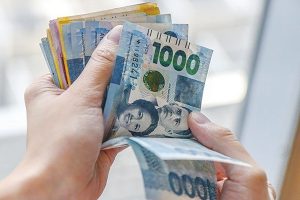Bloomberg
The Philippine peso is heading for its best quarter in 15 years but the bulk of its rally may already be over.
Growing headwinds facing the currency include accelerating inflation, rising oil import costs and a worsening trade balance. Technical signals also indicate the peso is approaching a level of resistance that may prove a barrier to further gains.
“We are bearish on the peso due to the wide trade deficit and negative real rates,†said Kiyong Seong, lead Asia macro strategist at Societe Generale SA in Hong Kong. “Elevated commodity prices and strong domestic demand mean imports may rise faster than exports.â€
The peso has surged about 6% this quarter, advancing along with most of its emerging Asian peers as the dollar has weakened. The currency appreciated to 55.17 per dollar, the strongest level since August.
One factor that may limit further gains is runaway inflation. The consumer price index jumped to 8% in November from a year earlier, the highest level in 14 years. While that may convince the central bank to keep hiking rates, it is also diminishing the real returns offered by the nation’s assets. CPI is now more than 300 basis points above the central bank’s 5% benchmark rate, versus an average of about 70 basis points above over the past five years.
Meanwhile, rising import costs are worsening the nation’s current-account balance. Policymakers raised their forecast for this year’s current-account deficit to a record $20.6 billion in September, about 8% higher than the earlier prediction of $19.1 billion.
“The peso will likely come under pressure again in the first quarter, given a sizable current-account deficit, relatively rich valuations and a challenging financing backdrop,†said Ashish Agrawal, head of foreign-exchange and emerging-market macro strategy research at Barclays Plc in Singapore.
The peso is also starting to look overvalued compared with its regional peers. The currency’s real effective exchange rate is 1% above its five-year average. In contrast, similar gauges for the Indonesian rupiah, Thai baht and Malaysian ringgit are all at least 4% below.
The technical outlook is starting to look negative too. The peso’s gains have taken it into overbought territory, from oversold just about two months ago, according to slow stochastics. Meanwhile, the currency’s gains are bringing it ever closer to its 200-day moving average, currently at 54.93, which has acted as a resistance level in
the past.
 The Gulf Time Newspaper One of the finest business newspapers in the UAE brought to you by our professional writers and editors.
The Gulf Time Newspaper One of the finest business newspapers in the UAE brought to you by our professional writers and editors.
